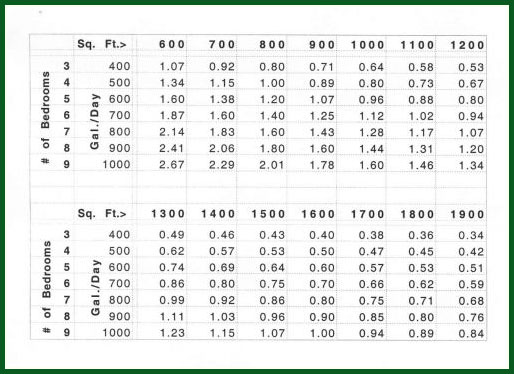This article discusses these topics:
- What does a Hydraulic Load Test (HLT) “do”?
- Why do an HLT?
- What is a Hydraulic Load Test?
- What is an HLT testing?
- Will an HLT hurt my absorption area?
- How much water is used?
- What about precipitation?
- What about snow?
- What about peak flow vs. normal flow?
- What are reasonable expectations for a buyer?
The HLT mimics the normal operating conditions in the absorption area. The HLT process is similar to a perc test. During an HLT, a known volume of clear liquid is introduced into the absorption area. The level of liquid in the absorption area is recorded both before and after the water is introduced. The inspector returns the following day and repeats the process.
The HLT is used to verify that the absorption area can receive and transmit to the soil environment the volume of liquid which the system is expected and intended to be able to handle on a peak-flow day.
When a system has been unused for a period of time because of vacations, seasonal use or the structure has simply been vacant, the normal operating conditions in the absorption area are not present for the inspector to observe. The longer the system has been unused, the longer it will take for normal conditions to return.
The NOF/PSMA Standards provide the opportunity to reestablish normal conditions to enable a complete inspection or an additional test can be performed. Either method is acceptable, however, time is often the deciding factor in selecting the process to be followed.
When a system displays the unintended condition of liquid standing in the aggregate, the absorption area is not performing as intended. When the level of liquid in the aggregate is above the holes in the distribution laterals, this unusual condition is of such concern that additional investigation is needed. The additional investigation called for in the NOF/PSMA Standards is a test known as a Hydraulic Load Test or HLT.
Some landowners resist a request from a buyer for an HLT to be conducted on their system. At first blush, this concern seems understandable, however, upon investigation it is seen to be unfounded.
“It’s gonna blow out the system,” is a commonly stated misconception. The table at the bottom of this page illustrates the relationship between the volume of water used during an HLT and a rainfall event.
The state or local regulation is consulted to determine the expected peak flow that the system should handle. In Pennsylvania, for example, the flow rate is four hundred gallons for one to three bedrooms. One hundred gallons are added for each additional bedroom. A five bedroom house must have a system that is able to receive and release to the soil environment six hundred gallons.
Is it unfair for the buyer to expect that the system he may own should be capable of properly handling the volume of sewage that the structure generates?
“We’ve had a lot of wet weather which caused the system to be full of water,” is another popular but unfounded reaction from property owners, either when they first learn an HLT is necessary or at the conclusion of the HLT. Again, the rainfall equivalent table sheds light on the situation.
For the aggregate to be saturated for its entire depth, which is usually 10 or 12 inches, three unusual and unexpected things must all have occurred:
- A significant and unprecedented amount of precipitation must have fallen in the immediate past few hours;
- None of the precipitation ran off, none became trapped in the soil matrix above the aggregate and all of the water percolated immediately to the aggregate;
- The water DID NOT LEAVE the absorption area by moving into the underlying soil as it is expected to but rather accumulated in the aggregate.
“But there was snow…” Yes, however, snow accumulates at a far greater rate than rain. On average, 10 in. of fallen snow is equivalent to 1 in. of rain. While there are heavier and lighter “snows,” the melting process, runoff, direct evaporation of snow, and reduced permeability of frozen soil all combine to spread the conversion of snow to water over time, diminish the actual amount of snow available to infiltrate and reduce the actual amount of water that can infiltrate. The issues regarding the behavior of rain all come into play when the melt water eventually enters the soil.
Is it unfair for the buyer to expect that the system he may own should work properly in rain, sleet, or snow?
Septic systems permitted since the early 1970s are designed to handle a peak flow based on the number of bedrooms in the house. A system’s treatment capacity is, by regulation, over designed! Peak flows are not “typical” flows; they are intended to be above the norm. If systems were designed solely to handle the normal flow, then systems would regularly fail when the family comes over for a birthday party, thanksgiving, a picnic or to watch the super bowl!
An HLT is done to replicate peak flow conditions. Indeed, only the peak flow is a known value since it is based on the number of bedrooms. The current occupant’s use pattern cannot be used to control the future occupant’s use patterns. Use differs from occupant to occupant based on a host of characteristics or patterns that may be attributable to the number of adults and children and their respective ages and genders. Use patterns may also be influenced by ethnic, dietary, or other very real, however, unpredictable characteristics or practices of those future occupants!
For all of these reasons, the volume of clean water used in the HLT is based on the prevailing regulation and it is introduced much like a peak load would be introduced to the system. This is why the load is not introduced over a period of 24 hours in a series of incremental loadings. Indeed, modern perc tests used to determine the size of a brand new septic system is conducted on a very compressed time frame of just four hours.
Is it unfair for the buyer to expect that the system can handle the flows from a celebration or when all the friends and relatives come over for the house warming party?
Rainfall Equivalents for HLT Loading
The following table correlates three factors.
- The number of bedrooms in a structure.
- The peak flow expected from the structure.
- The size of the absorption area in square feet.
The table indicates the equivalent inches of precipitation that a hydraulic load test will introduce into the absorption area.

What do the PSMA/NOF Inspection Standards Say? (version 2022)
REASONS FOR A HYDRAULIC LOAD TEST
A hydraulic load test shall be performed when during the course of a PSMA/NOF Inspection any of these conditions are discovered:
- Less than 24 hours’ volume capacity in cesspool or seepage pit
- Structure is vacant for more than seven days (1)
- When the treatment tank or cesspool or seepage pit has been pumped less than 30 days prior to the inspection (1)
- New gray water sources directed to the system within last 30 days (1)
- Soil fracturing activity within last 30 days (1)
- When initial inspection reveals that, for whatever reason, the treatment tank’s liquid level is below the outlet pipe (1)
- When standing effluent is discovered in an absorption area or gravelless chamber, the inspector shall consult the Dry Aggregate Rules to determine when an HLT is indicated
- A broken or clogged pipe, a dysfunctional D-box or other condition that would result in atypical flows reaching all or part of the system (1)
- Intermittent occupancy (e.g. vacation use, seasonal use) which the inspector concludes as atypical
- Recommended—when occupancy of a structure will increase from what it had been previously (1)
When the inspector is informed that the existing system will be subjected to increased daily flows resulting from increased occupancy or a change in the structure’s use, an HLT shall be recommended. The client may decline the recommendation.
(1) When a Hydraulic Load Test is indicated, if there is sufficient time available and with the concurrence of the inspector, the absorption area can be reinspected and re-evaluated when Occupancy for more than 30 continuous days is re-established and verified by the inspector.
PROCEDURES
Procedure For Gravity Fed Beds & Trenches:
- Locate the absorption area for the system,
a. For bed configurations, dig a minimum of one observation
hole to the surface of the aggregate at the center of the bed.
Bore or dig into the aggregate until the underlying soil/sand is
reached.
b. For trench style systems, dig a minimum of one observation
hole to the surface of the aggregate in each trench. Bore or dig
into the aggregate until the underlying soil/sand is reached. - For each hole, establish a fixed and recoverable reference point from which to measure.
- Measure the distance from the reference point to:
a. the surface of the aggregate
b. the soil underlying the aggregate
c. the surface of any liquid in the aggregate - Determine the liquid level in the aggregate before introducing water.
a. If the liquid level is at the top of the aggregate do not add
water, go to the conclusion page
b. If the liquid level is below the top of the aggregate, introduce
clean water into the absorption area until the calculated
volume has been added, or until the liquid level rises to the
top of the aggregate.
c. If, during an HLT, the liquid level rises to or above the top of
the aggregate, STOP introducing liquid and proceed to #7
(record liquid levels and volume used).
- Introduction of liquid for a hydraulic load test:
a. Introduce the liquid after the treatment tank on gravity fed
systems. - After the water has been added, for gravity distributed effluent,
wait 30 minutes for the liquid level to stabilize; then measure the
distance from the reference point to the surface of the water, and
record the liquid depth in each hole. - Return 24 hours later, measure and record the distance from the
reference point to the top of the liquid. - Introduce additional clean water to bring the liquid level to the
level achieved on the prior day, or introduce the calculated volume,
whichever is less. - Once again record the volume of water introduced.
Note: If the introduction of liquid is stopped on the first day because the liquid level has reached the top of the aggregate, and if the full calculated volume can be introduced on the second day, return a third day and repeat steps 6-9.
[THERE MAY BE PROCEDURAL DIFFERENCES BASED UPON THE ACTUAL TYPE OF SYSTEM PRESENT AND/OR ITS COMPONENTS]
HYDRAULIC LOAD TEST CONCLUSIONS
For all systems, only two conclusions are possible following a hydraulic load test. They are:
- The system has accepted and dispersed a volume of liquid equal
to the calculated volume (daily flow) that is expected from the
structure served, and is, therefore, “satisfactory.” - The system has not accepted and dispersed a volume of liquid
(daily flow) that is expected from the structure served, and is,
therefore, “unsatisfactory.”
Note: These conclusions relate to the hydraulic load test results but not to the conclusions of the entire system.
